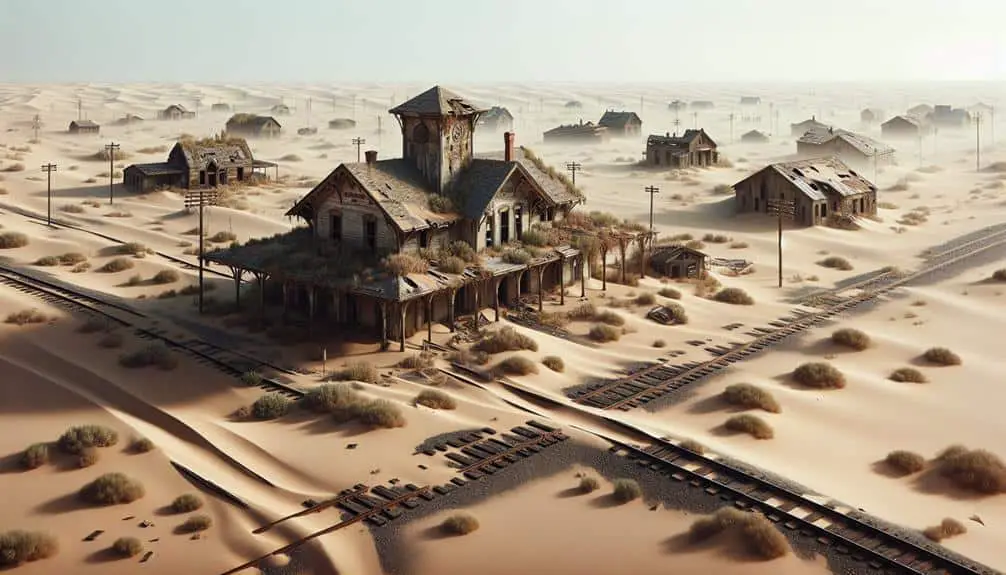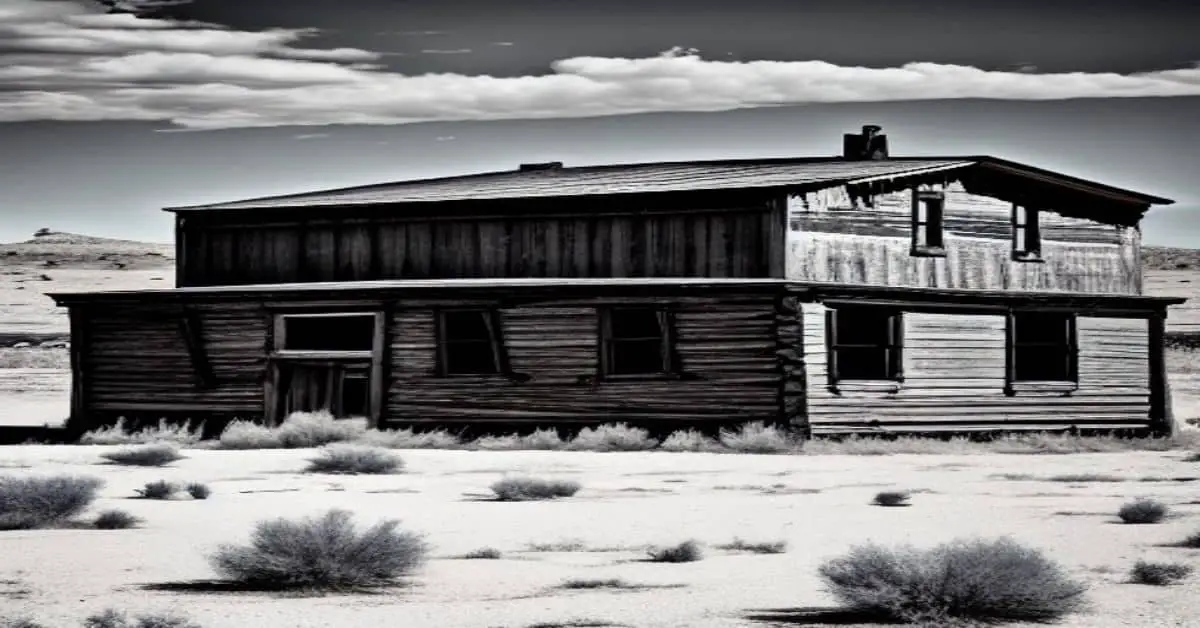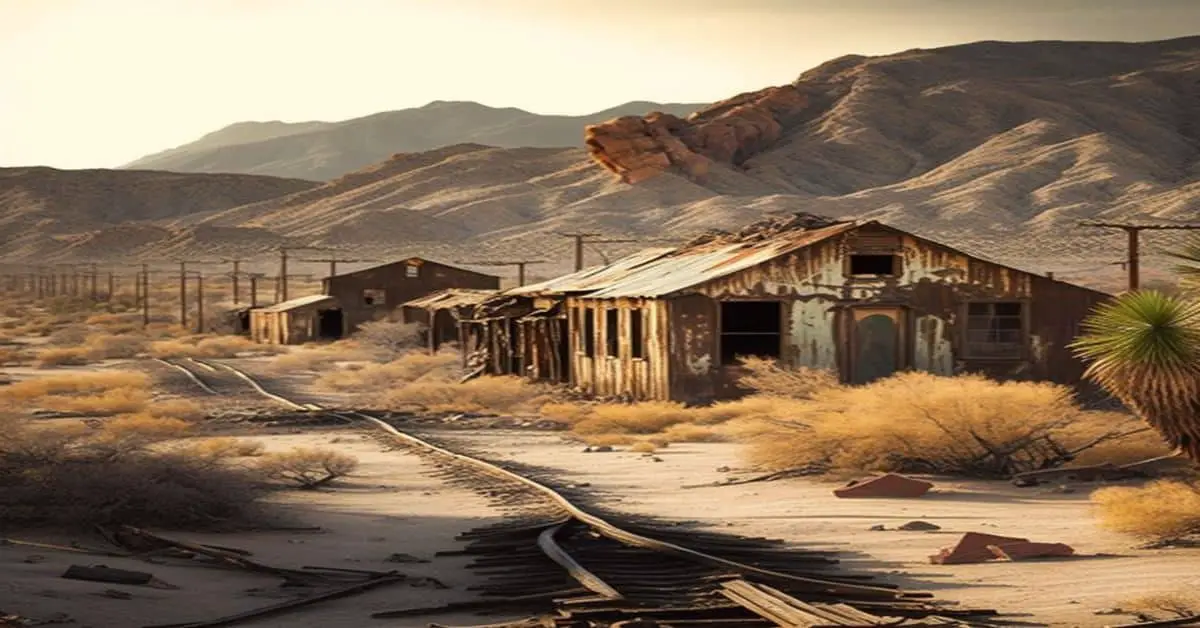Discover the lost stories of forgotten railroad towns in Arizona. Established during the late 19th century railway expansions, these communities thrived as economic hubs. Witness their rapid growth and eventual decline, leaving behind traces of abandoned infrastructure. Explore dilapidated train stations, crumbled homesteads, and faded storefronts that paint a picture of the past. Examine the economic impacts on these deserted areas, from loss of jobs to revitalization attempts attracting tourists. Learn about ongoing preservation efforts through historic building restoration and educational programs. Uncover the hidden histories and architectural legacies that define Arizona’s railroad towns.
Key Points
- Arizona’s railroad towns grew rapidly in the late 19th century.
- These towns faced boom-and-bust cycles due to economic shifts.
- Deserted towns display architectural remnants of their past glory.
- Abandoned areas impact the economy but hold revitalization potential.
- Preservation efforts focus on restoration, documentation, and education.
Origins of Arizona Railroad Towns
The origins of Arizona’s railroad towns can be traced back to the late 19th century when the expansion of railway networks transformed the state’s landscape and economy. Early settlers in Arizona saw the potential of establishing communities along the tracks, leading to the birth of numerous railroad towns. These towns were strategically located near the transportation infrastructure, allowing for easy movement of goods and people.
The influx of settlers and the development of these railroad towns played a pivotal role in shaping Arizona’s history. The towns became hubs of activity, attracting businesses, and fostering economic growth in the region. The transportation infrastructure provided by the railways facilitated trade and commerce, connecting Arizona to the rest of the country.
Boom and Bust of Railway Communities
Many railway communities in Arizona experienced rapid growth followed by sudden decline, a pattern reflecting the volatile nature of the state’s early economy. The influx of settlers, drawn by the promise of economic opportunities brought by the railroad, led to booming populations in these towns. However, as industries shifted, resources depleted, or rail lines were rerouted, many of these communities faced abrupt downturns, causing significant population fluctuations.
Urban planning in these towns often struggled to keep pace with the rapid growth, leading to haphazard development and infrastructure issues when the decline hit. The social dynamics within these railway communities also played an important role in their fates. While some towns managed to adapt and diversify their economies, showcasing community resilience, others faltered under the pressure of changing circumstances.
The boom and bust cycle of these railway communities left lasting impacts on Arizona’s landscape, with abandoned buildings and remnants bearing witness to the rise and fall of these once-thriving towns.
Architectural Remnants of Deserted Towns
Amid the remnants of abandoned railway communities in Arizona lie the architectural echoes of a bygone era, silently narrating the rise and fall of once-thriving towns. As you explore these architectural ruins, a sense of nostalgia and curiosity envelops you, prompting reflections on the lives of those who once inhabited these now-deserted places.
Here are some intriguing facets you may encounter on ghost town tours:
- Dilapidated Train Stations: Once bustling with activity, these stations now stand as weathered structures, offering a glimpse into the past when trains connected remote towns.
- Crumbled Homesteads: The decaying remains of homes and buildings hint at the daily lives of the families who once called these places home, now reclaimed by nature.
- Faded Storefronts: Storefronts that once buzzed with commerce now display faded signs and broken windows, remnants of a vibrant past.
- Rusty Railroad Tracks: The rusty tracks weaving through these towns symbolize the transportation networks that shaped the region’s development, now silent and unused.
- Whispers of History: Every brick, beam, and artifact whispers a story of the challenges and triumphs experienced by the inhabitants of these deserted towns.
Economic Impact on Abandoned Areas
Exploring the economic repercussions of deserted areas reveals a complex web of financial consequences intertwined with the abandonment of once-thriving communities. Ghost towns, remnants of a bygone era, stand as silent witnesses to economic shifts. The abandonment of these areas leads to a ripple effect on local economies. The most apparent impact is the loss of jobs and tax revenue, as businesses close and populations dwindle.
Abandoned infrastructure, once essential to transportation and trade, now lies dormant, posing both a challenge and an opportunity. While the cost of maintaining these structures can burden local governments, strategic revitalization efforts can turn them into tourist attractions. Tourism, drawn by the allure of exploring history frozen in time, can inject much-needed revenue into these forgotten towns. The economic potential of ghost towns lies in their ability to captivate visitors, offering a glimpse into the past while breathing new life into abandoned spaces.
Modern-Day Preservation Efforts
As the impact of abandonment reverberates through deserted areas, the focus shifts to the ongoing efforts aimed at preserving the remaining remnants of these forgotten railroad towns in Arizona. Preservation initiatives have gained momentum in recent years, with various organizations and local communities coming together to make sure that the history embedded in these towns isn’t lost to time. Community involvement plays an important role in these preservation efforts, as individuals volunteer their time and resources to restore old buildings, maintain historical sites, and organize events that celebrate the heritage of these towns.
Here are five key aspects of modern-day preservation efforts in Arizona:
- Historic Building Restoration: Dedicated teams work tirelessly to restore and preserve old railroad stations, depots, and other significant structures.
- Archival Documentation: Efforts are made to catalog and preserve historical documents, photographs, and artifacts related to these railroad towns.
- Educational Programs: Community-led initiatives offer educational programs and guided tours to raise awareness about the history of these towns.
- Public Events: Festivals, fairs, and exhibitions are organized to showcase the rich cultural heritage of these forgotten communities.
- Collaborative Partnerships: Partnerships between local governments, historical societies, and preservation groups help pool resources and expertise for the conservation of these towns.
Frequently Asked Questions
What Impact Did the Construction of Railroad Towns Have on Native American Communities in Arizona?
When railroad towns sprouted in Arizona, their impact on Native American communities was profound. Cultural preservation suffered as traditional lands were disrupted, leading to loss of autonomy and resources. The railroad’s presence altered the social fabric considerably.
Were There Any Notable Incidents or Conflicts Between Different Ethnic or Immigrant Groups in These Forgotten Railroad Towns?
In these forgotten railroad towns, ethnic tensions often flared up, leading to immigration conflicts between different groups. These incidents highlighted the challenges faced by diverse communities trying to coexist in a changing environment.
How Did the Great Depression and Other National Economic Crises Affect the Sustainability of Arizona’s Railway Communities?
During the Great Depression and other economic crises, Arizona’s railway communities faced severe challenges. Impact of migration brought strain, and economic hardships worsened sustainability. Towns grappled with dwindling resources and job losses, testing their resilience.
Are There Any Ghost Stories or Urban Legends Associated With the Deserted Railroad Towns in Arizona?
You might find eerie tales and spooky legends tied to the deserted towns along Arizona’s old rail lines. Ghost sightings and haunted stories add a mysterious layer to these abandoned places, intriguing curious minds.
Have Any Archaeological Discoveries Been Made in These Abandoned Areas That Shed Light on the Daily Lives of Residents in the Past?
Archaeological findings in these deserted areas have unearthed insights into residents’ daily routines. Discoveries provide glimpses into community dynamics, revealing the lives of past inhabitants through remnants of their homes, tools, and personal belongings.



